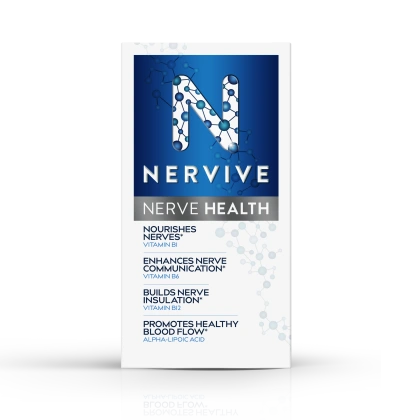B Complex Vitamins and Your Nervous System
The B Complex Vitamins are a group of 8 essential nutrients that share certain characteristics, and are often found together in the same foods.1 They provide vital support to every cell of your body, and your nervous system is no exception. Nourishing nerves, enhancing their communication, and maintaining the insulation that protects healthy nerves all require the presence and participation of B vitamins.1
What are B Complex Vitamins?
B Vitamins are important for making sure the body's cells are functioning properly. They are important building blocks of a healthy body and are vital for maintaining health. They are also water-soluble.1 They’re often referred to as the B Vitamin family or B Complex Vitamins. The 8 members of the B Complex Vitamins include: Thiamine (B1), Riboflavin (B2), Niacin (B3), Pantothenic Acid (B5), Pyridoxine (B6), Biotin (B7), Folate (B9), And Cobalamin (B12).
The functions of B vitamins are plentiful and diverse. B vitamins keep your cells fueled by helping to extract the energy contained in the foods you eat.2 They also support and promote healthy nerve function.3,4
How to Get B Complex Vitamins
Foods
B Complex Vitamins are present in a wide variety of foods. A balanced diet can usually provide enough to reach the recommended daily value. Here’s a quick rundown on some foods that are sources for one or more of the B vitamins:
Meats, Poultry, and Fish: While you might think of the meats, poultry, and fish on your plate mostly as protein sources, these foods are also contributing to your daily values of several B vitamins, particularly B1, B3, B5, B6, and B12.5 A 3-ounce serving of pork contains 33% of the daily value of Vitamin B1 6 and a 3-ounce serving of chicken provides 29% of your daily requirement for B67 along with other B vitamins.
Grains: Rice, barley and other grains are great sources of B2, B3, B5, B7, and B9.5 But keep in mind that when grains are processed their outer layer is removed, which also strips away most of the B vitamins. As a result, white rice contains about one-fifth the amount of vitamins B1 and B3, and one-fourth of the amount of vitamin B9 as brown rice.8,9To leverage the nutritional power of grains to your full advantage it’s always best to choose whole grains.
Dark Green Vegetables: Green veggies are a great way to pack in a lot of nutrition for not a lot of calories. They offer a wealth of vitamins and minerals, including B vitamins. Broccoli contains 7 out of 8 B Complex Vitamins. A 3.5 ounce serving of cooked broccoli provides 12% of your daily recommended amount of B610 and you can get 28% of your folic acid needs met with one 3.5 ounce serving of cooked spinach.17
Fruits: Some of the most popular fruits, including watermelon, bananas, oranges, strawberries, and mangoes are good sources of B Complex Vitamins, especially B1, B5, B6, and B9.5 Avocadoes, another popular fruit, pack 30% of an adult daily recommended allowance for vitamin B9 per fruit.11
Legumes, including beans, lentils, and garbanzo beans, contain B6, B7, and B9.5 Standout sources include black beans, which provide 33% of your daily recommended amount of B1 per ½ cup serving6 and peanuts, which provide 32% of your daily allowance of B9 per 3.5 ounce serving.13
Dairy provides an array of B vitamins.14 A 3.5-ounce serving of nonfat Greek yogurt provides 29% of an adult’s recommended daily amount of B12.15
How Much B Vitamin You Need Daily
Although B Complex Vitamins work together in the body, they are also unique, providing different functions that benefit the body and therefore are required in different amounts daily. Daily recommended amounts for B Complex Vitamins are as follows:16
- B1: 1.2 mg
- B2: 1.3 mg
- B3: 16 mg
- B5: 5 mg
- B6: 1.7mg
- B7: 30 mcg
- B9: 400 mcg
- B12: 2.4 mcg
How the B Complex Vitamins Help Your Nervous System
All B Complex Vitamins contribute to the health of the human body – but some play essential roles in the peripheral nervous system (the nervous system outside of the brain and spinal cord). Nerve cells rely on a sufficient and steady supply of B Vitamins for optimal health, especially as we age.3
As part of the aging process, peripheral nerves naturally undergo changes which may impact function.3
Three B complex vitamins play a particularly significant role in supporting healthy nerve function; these are vitamins B1, B6, and B12.
Keep reading to learn more about each of these B Vitamins and how they promote nerve health.
Vitamin B1
Your nerves are primarily fueled by energy from carbohydrates and vitamin B1 plays a major role in extracting that energy, and converting it into ATP, the molecule that supplies cells with their energy.4 Vitamin B1 nourishes nerves by funneling important components for ATP production into the ATP assembly line.4
Vitamin B6
Vitamin B6 enhances nerve communications. Nerve cells communicate with each other and directly to muscles using chemical messengers such as serotonin, dopamine, and others, collectively known as neurotransmitters. These chemical messengers are protein molecules and vitamin B6 is a necessary cofactor in their production.1
Vitamin B12
Vitamin B12 helps build and maintain myelin, the insulation that protects healthy nerve cells. B12 is needed for production of a particular protein that contributes to the structure of myelin.4 Inadequate levels of B12 can delay the regeneration process, meaning poorly insulated nerve cells aren’t able to convey their messages efficiently.4
B Complex Vitamins and Nervive Nerve Health
Nervive Nerve Health provides the three essential B vitamin building blocks for promoting a healthy nervous system by providing 1000% of the daily recommended amounts of vitamins B1, B6, and B12 per serving*. In Nervive Nerve Health:
- B1 nourishes and energizes for your nerves*
- B6 enhances nerve communication
- B12 maintains healthy nerve insulation*
Nervive Nerve Health also contains alpha-lipoic acid, an antioxidant that promotes healthy blood flow to the nerves.*
References
- B Vitamins in the nervous system: Current knowledge of the biochemical modes of action and synergies of thiamine, pyridoxine, and cobalamin - Calderón‐Ospina 2020 - CNS Neuroscience & Therapeutics - Wiley Online Library. 2022 https://onlinelibrary.wiley.com/doi/full/10.1111/cns.13207
- B-complex vitamins' role in energy release. 2006; Available from: https://vc.bridgew.edu/cgi/viewcontent.cgi?article=1029&context=mahpls_fac.
- Influence of aging on peripheral nerve function and regeneration - Verdú - 2000 - Journal of the Peripheral Nervous System - Wiley Online Library. 2022 https://onlinelibrary.wiley.com/doi/full/10.1111/j.1529-8027.2000.00026.x
- The Role of Neurotropic B Vitamins in Nerve Regeneration. BioMed research international, 2021. 2021 https://www.ncbi.nlm.nih.gov/pubmed/34337067
- The best foods for vitamins and minerals - Harvard Health. 2016 https://www.health.harvard.edu/staying-healthy/the-best-foods-for-vitamins-and-minerals
- Office of Dietary Supplements - Thiamin. 2022; Available from: https://ods.od.nih.gov/factsheets/Thiamin-HealthProfessional/
- Office of Dietary Supplements - Vitamin B6. 2022; Available from: https://ods.od.nih.gov/factsheets/VitaminB6-HealthProfessional/
- FoodData Central Rice, white, glutinous, unenriched, cooked. 2022; Available from: https://fdc.nal.usda.gov/fdc-app.html#/food-details/169711/nutrients
- FoodData Central Rice, brown, medium-grain, cooked. 2022; Available from: https://fdc.nal.usda.gov/fdc-app.html#/food-details/168875/nutrients.
- FoodData Central - Broccoli, cooked, boiled, drained, with salt. 2022; Available from: https://fdc.nal.usda.gov/fdc-app.html#/food-details/168510/nutrients.
- FoodData Central - Avocado. 2022; Available from: https://fdc.nal.usda.gov/fdc-app.html#/food-details/171706/nutrients.
- FoodData Central Beans, black, mature seeds, cooked, boiled, with salt. 2022; Available from: https://fdc.nal.usda.gov/fdc-app.html#/food-details/175237/nutrients.
- FoodData Central Peanuts, valencia, oil-roasted, with salt. 2022; Available from: https://fdc.nal.usda.gov/fdc-app.html#/food-details/172433/nutrients.
- Milk, reduced fat, fluid, 2% milkfat, with added vitamin A and vitamin D. 2022; Available from: https://fdc.nal.usda.gov/fdc-app.html#/food-details/746778/nutrients.
- FoodData Central Yogurt, Greek, plain, nonfat. Available from: https://fdc.nal.usda.gov/fdc-app.html#/food-details/330137/nutrients.
- Office of Dietary Supplements - Daily Values (DVs). 2022; Available from: https://ods.od.nih.gov/HealthInformation/dailyvalues.aspx.
- FoodData Central Spinach, mature. 2022; Available from: https://fdc.nal.usda.gov/fdc-app.html#/food-details/1999633/nutrients.



